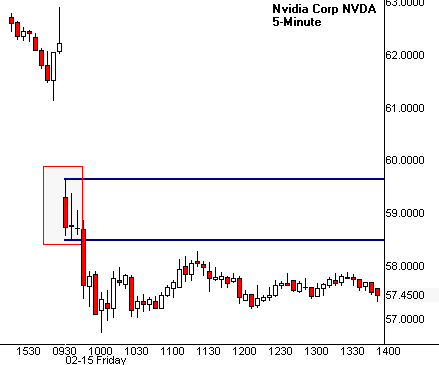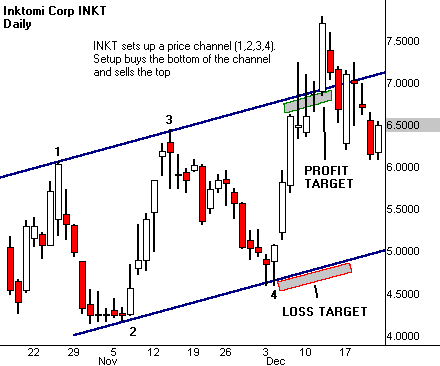Technical Analysis Tutorial Mastering The Momentum Trade
Post on: 16 Июнь, 2015 No Comment

Mastering The Momentum Trade
Pattern Cycles generate powerful strategies to capitalize on changing conditions and major turning points. But most traders fall into the momentum game and never learn other tactics. While the greedy eye sees rising trends with few pullbacks, most still lose money chasing a hot market. They realize too late that momentum demands precise timing and strict emotional control.
Focus on the big gain dulls awareness of the big loss. Market insiders adjust quickly to the momentum crowd and generate sharp whipsaws to shakeout the weak hands. Confused participants start buying tops and selling bottoms with regularity. Or they abandon their rules and try to survive by holding old winners through violent selloffs and waiting for a bounce.
Trend-Range Axis: The untrained eye sees continuous price change but trends last only a short time compared to constricted ranges. During one phase of Rambus’ February move, the stock printed 15 trend bars compared to 53 sideways range bars. Without excellent timing, momentum traders have many opportunities to fail.
Sharp trends print wide range bars and many gapping moves. This volatility increases risk and inhibits safe entry-exit planning. Swing traders rely on support-resistance to define execution and reward targeting. Momentum markets often display no common landscape features at all. This requires entry without a clear violation level that proves that the setup was wrong. In this blind environment, arbitrary stop losses may be the only way to keep the speculator out of intense danger.
Momentum trading can be mastered. Three disciplines will break destructive habits and reprogram trading for success:
- Abandon the adrenaline rush: Forget the excitement. Profit depends upon detached and disciplined execution.
- Learn the numbers: The nature of price movement must be ingrained deeply enough to allow spontaneous decision-making during the trading day.
- Cross-verify: Objective measurements must filter unconscious bias.
Reduce momentum risk through 3-D charting. Identify reward for the time frame of interest. Confirm that the stock shows no important divergences that may signal the end of the move or an impending reversal. Then guide execution and position management through the chart in the next lower dimension. When a strong trend explodes on the daily view, use a 60-min bar to pick out low risk entry and define natural exit points. For intraday positions, control the 5-min bar breakout by using a 1-min chart to locate the natural swings.
Successful momentum strategy requires solid tape reading skills. Demand on the time and sales ticker reveals the inner workings of rapid price movement. Both retail (small lot) and professional (large lot) traders need to participate in a sharp trend or it will fail. Watch the crowd’s response to support numbers very closely. If you can’t feel their urgency to get on board, perhaps it isn’t there. When the action pushes into uncharted territory, use round numbers to gauge demand. Multiples of 10 present strong resistance in place of classic support levels. Understand the motives of the big players that drive fast markets and ride their coattails to gain a needed edge. And if you see big lots move against a rally, be prepared to join them.
Time of day tendencies create profit and danger zones. As the market opens, overnight imbalance and fresh retail cash trigger volatility that resolves through price change. Insiders guide stop gunning exercises and fade trends through the lunch hour’s negative feedback. The final hour arrives, just in time to resolve many complex themes with sharp breakouts or breakdowns. And through it all, intraday buying and selling oscillates in an orderly 90-min cycle.

Riding Intraday Swings: Intraday volatility shakes out day traders during a 3-hour, 16-point NXTL rally. Short-term price movement responds to numerous intermarket cycles that ensure a bumpy rise for the momentum crowd.
Technical analysis uncovers momentum secrets as it exposes insider deception and herd emotions. Verify all shock events through both patterns and indicators. Proper application will reduce entries associated with false breakouts and invoke natural risk management. Always trade by the numbers and not the news. Use their cold logic to painlessly exit momentum positions and move on quickly to the next opportunity.
Physics teaches that an object in motion tends to remain in motion. Profits depend on this well-understood mechanism. Moving averages set to multiple time frames reveal trend velocity through their relationships with each other. Measure this acceleration-deceleration with a classic MACD indicator or apply MA Ribbons to see if they spread or contract over different time periods. For obvious reasons, always seek acceleration cross-verification before momentum trade execution.
Swing traders apply original tactics to each phase of the Pattern Cycle. At new highs, they execute momentum setups that rely on sound risk management. When market conditions change, they move swiftly onto fresh ideas that reflect the new inefficiencies. Always opportunistic, they seek the next profit like the predator looks for vulnerable prey.
Momentum strategies fail through most market conditions. Stocks trend only 15% to 20% of the time. Constricted ranges bind price during the rest of its existence. Trading longevity requires diverse skills through both trending and congested markets. Be flexible enough to shift from one strategy to the other as feedback loops alternate between positive and negative. In other words, adapt tactics quickly to changing market conditions rather than wait for those limited times when the environment favors the hot stock.














